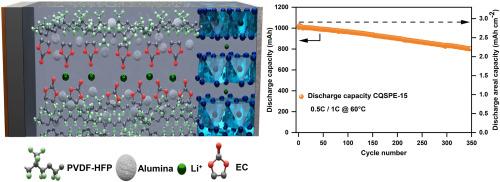Advanced PVDF-HFP-based composite quasi-solid polymer electrolyte for high-energy lithium-ion batteries with enhanced safety and durability
IF 7.9
2区 工程技术
Q1 CHEMISTRY, PHYSICAL
引用次数: 0
Abstract
The development of high-energy lithium-ion batteries (LIBs) with enhanced safety and durability requires overcoming challenges related to electrolyte instability, low ionic conductivity, and inadequate mechanical strength. This study introduces a composite quasi-solid polymer electrolyte (CQSPE) based on PVDF-HFP, optimized with Al2O3 nanoparticles to enhance fire retardancy, mechanical strength, ionic conductivity, and interfacial stability. The CQSPE containing 15 wt% Al2O3 exhibits a high ionic conductivity of 6.5 mS cm−1 at 60 °C and a tensile strength of 1.56 MPa, effectively suppressing dendrite formation during cycling. The influence of CQSPE thickness (30, 60, and 90 μm) on electrochemical performance is systematically analyzed. The 60 μm membrane demonstrates optimal performance, with superior plasticizer retention and balanced mechanical properties. In a full-cell configuration (Gr-SiOx|CQSPE|NCM622), the 60 μm electrolyte delivers a reversible areal capacity of 2.61 mAh cm−2 with 72.96 % capacity retention after 300 cycles at 0.5C. Additionally, a double-layered pouch cell with this optimized CQSPE exhibits an initial discharge capacity of 1 Ah (2.76 mAh cm−2) and 79.6 % capacity retention over 350 cycles at 0.5C/1C. The facile structural design of CQSPE provides a promising pathway for the development of high-performance solid-state lithium-ion batteries in the near future.

用于高能锂离子电池的新型pvdf - hfp复合准固体聚合物电解质,增强了安全性和耐用性
提高安全性和耐用性的高能锂离子电池(lib)的发展需要克服与电解质不稳定、低离子电导率和机械强度不足相关的挑战。本研究介绍了一种基于PVDF-HFP的复合准固体聚合物电解质(CQSPE),并通过Al2O3纳米颗粒进行优化,以提高其阻燃性、机械强度、离子电导率和界面稳定性。含有15 wt% Al2O3的CQSPE在60℃时具有6.5 mS cm−1的高离子电导率和1.56 MPa的抗拉强度,有效抑制了循环过程中枝晶的形成。系统分析了CQSPE厚度(30、60和90 μm)对电化学性能的影响。60 μm的膜表现出最佳的性能,具有优异的增塑剂保留和平衡的机械性能。在全电池配置(Gr-SiOx|CQSPE|NCM622)中,60 μm电解质在0.5C下循环300次后提供2.61 mAh cm - 2的可逆面积容量,容量保持率为72.96%。此外,具有这种优化的CQSPE的双层袋状电池在0.5C/1C下的初始放电容量为1 Ah (2.76 mAh cm - 2),在350次循环中容量保持率为79.6%。CQSPE的简单结构设计为高性能固态锂离子电池的发展提供了一条有前途的途径。
本文章由计算机程序翻译,如有差异,请以英文原文为准。
求助全文
约1分钟内获得全文
求助全文
来源期刊

Journal of Power Sources
工程技术-电化学
CiteScore
16.40
自引率
6.50%
发文量
1249
审稿时长
36 days
期刊介绍:
The Journal of Power Sources is a publication catering to researchers and technologists interested in various aspects of the science, technology, and applications of electrochemical power sources. It covers original research and reviews on primary and secondary batteries, fuel cells, supercapacitors, and photo-electrochemical cells.
Topics considered include the research, development and applications of nanomaterials and novel componentry for these devices. Examples of applications of these electrochemical power sources include:
• Portable electronics
• Electric and Hybrid Electric Vehicles
• Uninterruptible Power Supply (UPS) systems
• Storage of renewable energy
• Satellites and deep space probes
• Boats and ships, drones and aircrafts
• Wearable energy storage systems
 求助内容:
求助内容: 应助结果提醒方式:
应助结果提醒方式:


